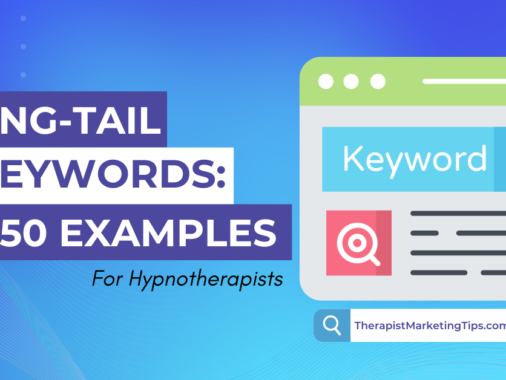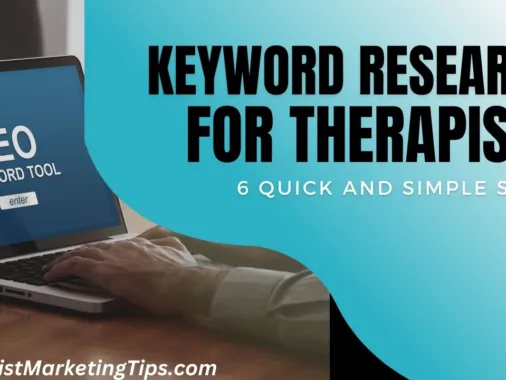Understanding user intent is the first step towards effectively using SEO (Search Engine Optimization) to grow your therapy practice website.
In the most basic sense, the concept of “user intent” refers to the underlying reason or purpose behind the search terms people enter into Google.
In this guide, you’ll learn about the different types of user intent, how each type affects your SEO strategy, and how to use your knowledge of this fundamental principle to grow your practice online.
Why Understanding User Intent Matters
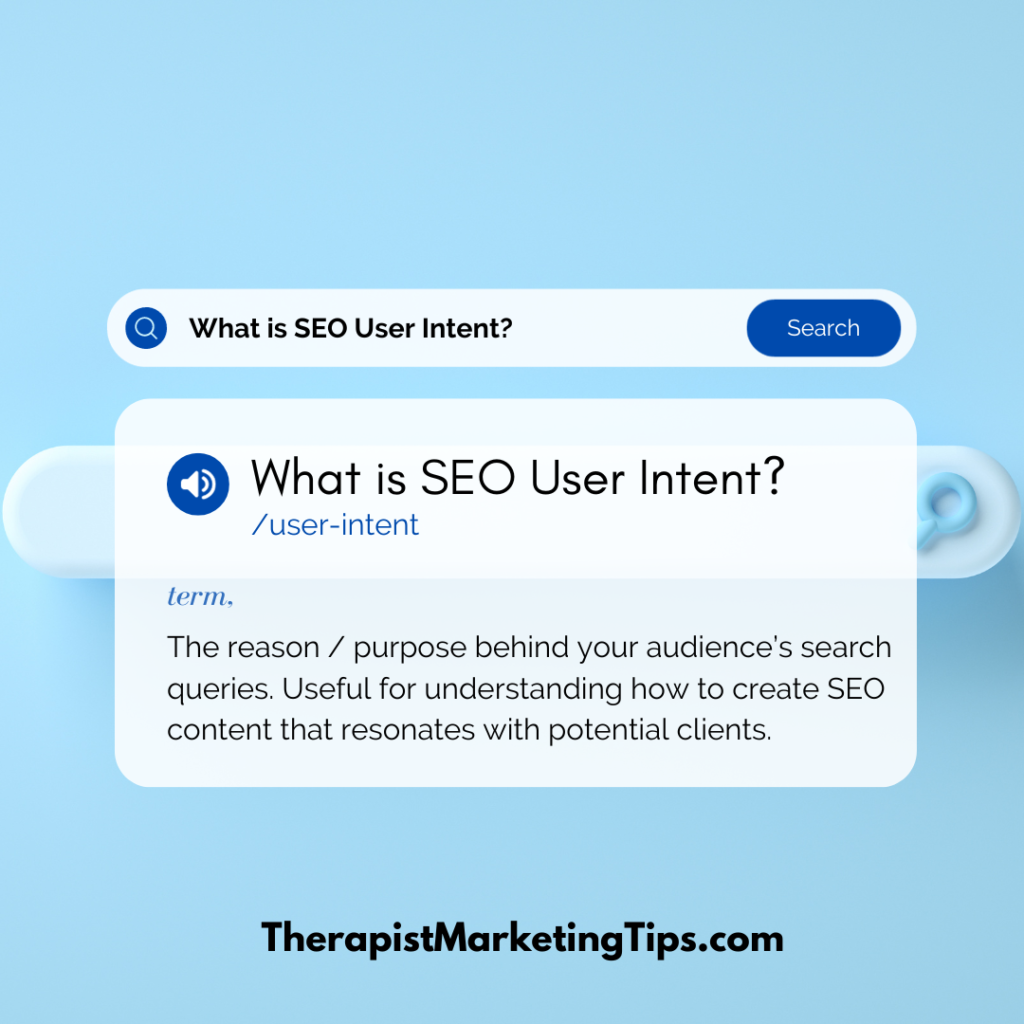
When you begin optimizing your therapy practice website to get better rankings in Google search results, the first task you’ll undertake is keyword research.
As you’ll learn in my beginner’s guide to keyword research, this involves digging in to find the actual words and phrases people type into search engines to find services and information relevant to your business.
Finding these terms (known as keywords) means you can then add them to your website so that search engines like Google will display your content in the search results when people look for them.
For example, if you offer walk-and-talk therapy, you would target keywords related to that service so that your therapy practice appears in the search results for that term. From there, the idea is that users click through to your website, get the information they need from you, and eventually become clients.
As any expert on the subject will tell you, that’s a very basic explanation of how SEO works. Things get a little more complicated when you consider that not everyone who searches for your target keywords is looking for the same information.
Some may be right at the start of their journey and simply want to learn about the benefits and effectiveness of walk-and-talk to help them decide if it’s a good option for them. Others, meanwhile, may be further along in their journey and researching the best walk-and-talk therapist to work with.
This is why understanding user intent is so important.
In this example, people are searching for similar things but for very different reasons.
Targeting those users in the learning phase with a hard-sell landing page explaining why you’re the best walk-and-talk therapist isn’t going to be that effective since they’re not yet ready for that.
Nor will you get the best results from targeting people looking to hire a therapist with a blog post extolling the virtues of walk-and-talk since those users are already past that stage and are now looking to book an appointment with a therapist.
When you understand the “why” behind your chosen keyword, you’re in a better position to create SEO content that gives your audience exactly what they want, and when you give people what they want, you start to reap a host of benefits, including:
1. Better Conversion Rates
When your content aligns with the user’s stage of the decision-making process, whether it’s informational or transactional, you’re more likely to convert website visitors into clients.
You can offer the right call-to-action at the right time, whether it’s providing in-depth information, scheduling an appointment, or requesting more details.
2. Improved User Experiences
By tailoring your content to match the user’s intent, you create a more satisfying and relevant experience for visitors to your website.
This increases the likelihood that they will engage with your content and explore your therapy practice further.
The best part about all this is that the more time users spend engaging with your website, the more search engines see your website as a useful and valuable source of information relating to your keyword.
This helps you to appear higher in search results and drive more visitors to your site.
3. Reduced Bounce Rate
Bounce rate refers to the number of visitors who land on your website but leave after visiting just one page.
Websites with high bounce rates aren’t perceived favorably by Google, which means they typically get ranked lower in the search results and don’t drive a lot of visitors.
As you can imagine, if a user lands on your site and doesn’t find exactly what they’re looking for, they’ll soon leave.
As a result, your bounce rate goes up, and your traffic goes down.
However, if you create content that precisely matches the intent behind a user’s search term, they’re more likely to stick around, sending positive, rank-boosting signals to search engines.
4. Establish Authority and Trust
Offering valuable, targeted information establishes your practice as an authority in your field. Users are more likely to trust your expertise and choose your services when they find answers to their specific questions and needs.
What’s more, authority and trust are key factors used by Google in determining the most helpful content to show search search users.
So, the more you can do to establish yourself as an authoritative source of information, the better your search rankings.
5. Gain a Competitive Advantage
Finally, it’s worth noting that understanding user intent and addressing the exact needs of your audience can help set you apart from competitors who may not be as attuned to their audience’s needs.
Ultimately, what all this comes down to isn’t just getting your therapy practice website to show up in search results but ensuring that it serves as a valuable resource for users at every stage of their journey toward seeking therapy services.
The 5 Different Types of SEO Search Intent
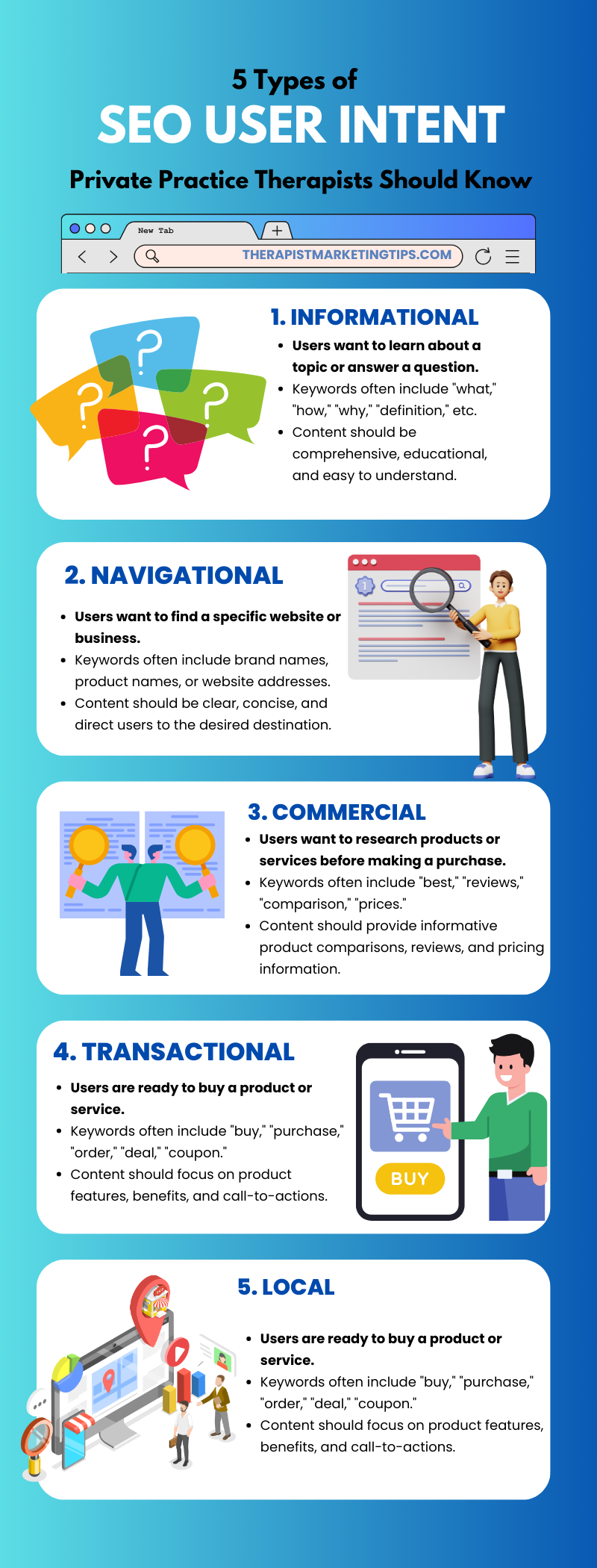
The key to meeting the intent of your user’s search queries and giving them precisely what they want is to understand the five different types of user intent.
In the world of SEO, there are generally considered to be five different types of user intent.
Learning about each type will give you a better understanding of the type of SEO content you should be creating to give your audiences what they’re looking for.
1. Informational Intent
Informational intent is exactly what it sounds like:
The intent behind a user’s search query is to find information and knowledge.
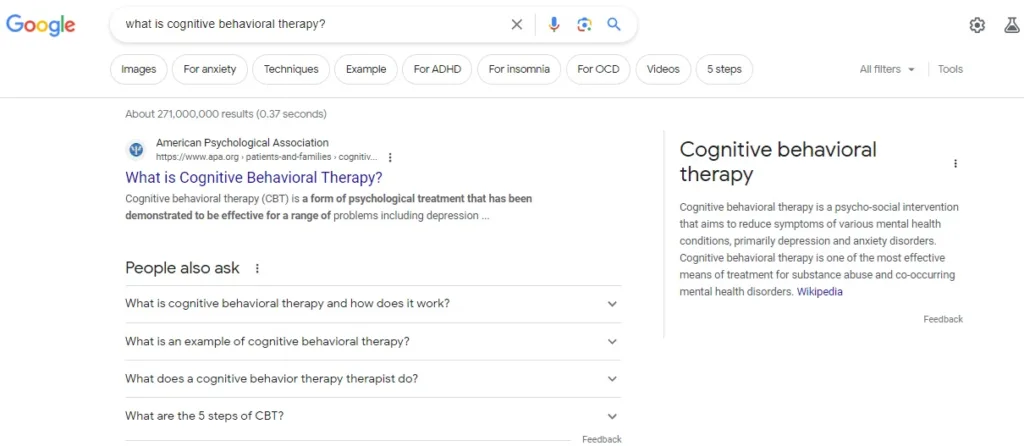
A long-tail keyword such as “What is cognitive behavioral therapy?” is a great example of informational intent.
Here, users aren’t necessarily looking to hire a therapist or find CBT resources. They simply want to learn about the subject and possibly explore whether it might be a suitable solution for them.
It’s best to target SEO keywords with informational intent by creating informative, authoritative, and educational content that addresses common questions and concerns within your therapy niche.
Think Beginner’s guide style posts, how-tos, or a series of blogs featuring a deep dive into an area you specialize in.
When crafting content for informational intent, aim to provide in-depth explanations, practical tips, and valuable insights that draw on both your professional expertise and unique experience.
By doing so, you position yourself as a trusted source of information and a credible expert in your field.
Your content should not only answer users’ questions but also offer a deeper understanding of the topic.
Remember, the goal isn’t just to capture fleeting attention but to leave a lasting impact. By catering to informational intent, you’re sowing the seeds of trust and authority that can lead users on a journey of discovery, eventually converting them into loyal clients who value your expertise.
2. Navigational Intent
If a keyword has navigational intent, that means users are trying to navigate to a particular website or find a specific organization.
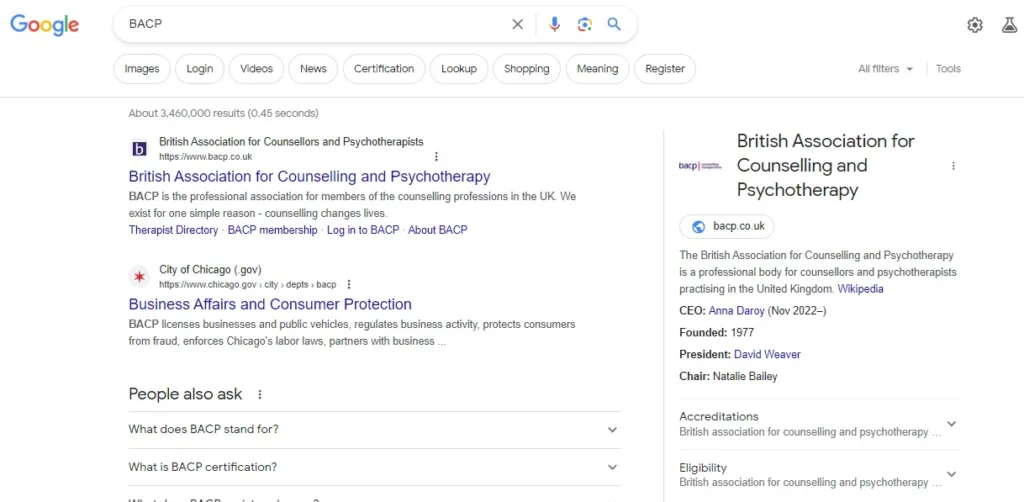
For example, it may be that a potential client you spoke to remembers the name of your therapy practice but none of your contact details. So, they head to Google and enter your practice name in an effort to find you.
That makes Your Therapy Practice Name a navigational keyword.
Likewise, if you were struggling to remember the URL for that amazing private practice marketing blog you came across, you might search for “Therapist Marketing Tips” to find this site.
Here, “Therapist Marketing Tips” is a keyword with navigational intent.
Targeting these navigational intent keywords is less about creating content or resources and more about ensuring that your brand is present and recognizable online so that people can easily find you.
It’s about maintaining Name, Address, Phone Number (NAP) consistency across your online presence and using off-page SEO strategies such as local listings and social media to grow your presence beyond the confines of your website.
3. Commercial Intent
Commercial intent, the next facet of SEO user intent, opens the door to a world of opportunities to connect with clients who are actively exploring therapy options and services.
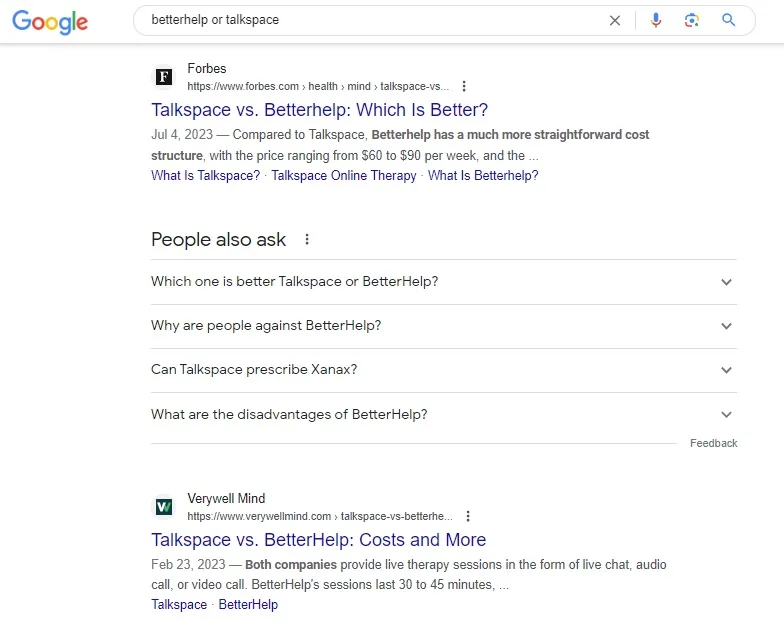
When users exhibit commercial intent, they are on the verge of making a significant decision.
In the case of the therapy industry, that decision is typically “Which therapist should I work with?”
Those users are ready to book an appointment and hand over their payment information. They just haven’t yet decided who to go with.
For example, consider a user searching for “best cognitive behavioral therapists in New York City.”
Here’s a search query with a very strong commercial intent.
These users aren’t seeking information about CBT. They already have all the information they need and have decided to find the best therapist to work with, but they haven’t found them yet.
With content focused on meeting commercial intent keywords, you can start to guide those users toward picking you as their chosen therapist.
To do that, your landing pages should clearly communicate what sets your therapy practice apart from others.
Why should clients choose you over another therapist? Is it your experience, your unique approach? A discreet yet convenient location?
It’s also worth noting that some users with commercial intent want to know about therapy costs and payment options upfront. Provide transparent information about your pricing structure, and you’ll help make their final decision much easier.
Typically, most SEO experts will tell you that including reviews and testimonials is a great way to capture users with commercial intent. However, given that this is a big ethical issue in the world of therapy practice marketing, I’d advise you to exercise caution with this one.
4. Transactional Intent
Users with transactional intent have moved beyond the research and evaluation stage and are ready to take concrete actions. As a therapist, this is the moment when you can guide these individuals toward booking appointments, consultations, or other specific interactions.
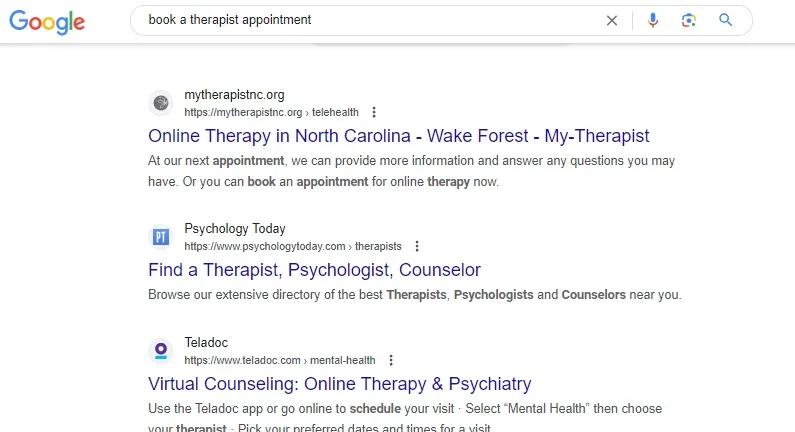
Imagine you’re a therapist, and someone has just decided that they want to schedule an appointment with you or purchase one of your self-help resources. Transactional intent is your opportunity to facilitate this action seamlessly and ensure a smooth and positive experience for potential clients.
Transactional intent keywords are characterized by phrases like “schedule an appointment with a therapist” or “buy self-help books online.” These users aren’t merely seeking information or comparing options; they’re prepared to engage with your services or products.
To cater to transactional intent and convert these users into clients, therapists can focus on the following strategies:
- Clear Calls-to-Action (CTAs) – Ensure that your website and content feature prominent and persuasive CTAs that guide users to take action. These CTAs may include “Book Now,” “Schedule an Appointment,” or “Buy Now.”
- Streamlined Booking Processes – Simplify the process of scheduling appointments or purchasing services/products on your website. A user-friendly and secure interface is essential to encourage transactions.
- Payment Options – Provide transparent information about payment methods, pricing, and any associated costs to eliminate uncertainty and foster trust.
- Appointment Booking System – Implement an efficient and automated appointment booking system that allows users to choose convenient dates and times.
- Immediate Contact Options – Offer options for immediate contact, such as live chat or click-to-call functionality, to assist users in the transaction process.
5. Local Intent
Unless you’re an online-only therapist, local search intent will play a critical role in your therapy practice SEO, helping you to cater to people in your direct local area.
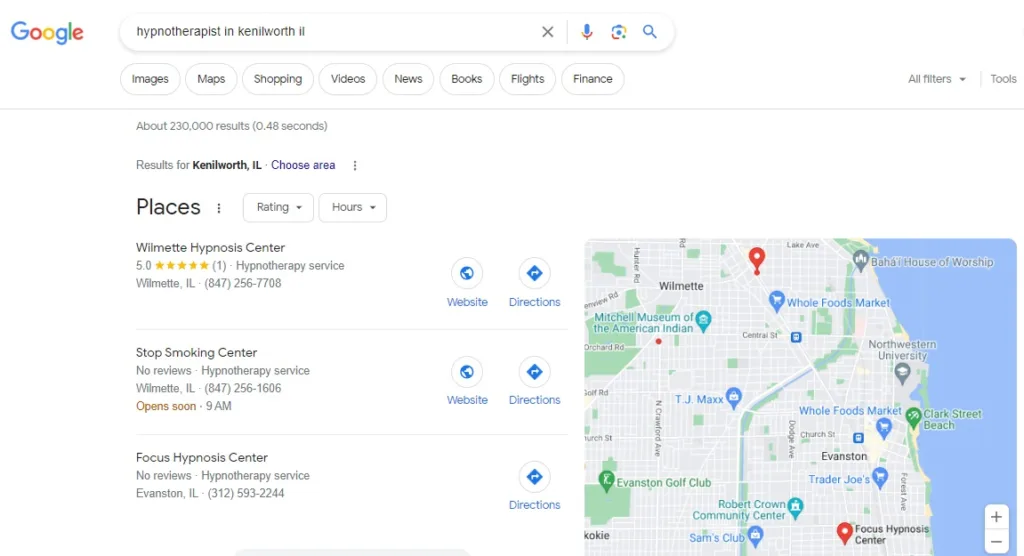
Consider the scenario:
A potential client is looking for therapy services close to home, or they want to find a therapist who understands the local community’s unique challenges and culture. This is where local intent comes into play, guiding users to therapists who are conveniently located and familiar with the area.
Keywords with local intent often include geographic modifiers, such as “Therapists near me” or “Psychologists in Los Angeles.” These users are not interested in general information or broad searches; they want to find therapy options that are accessible to them in the area where they live.
To address local intent and maximize your reach to potential clients in your area, therapists can focus on the following strategies:
- Google My Business (GMB) Optimization: Claim and optimize your Google My Business listing to enhance your visibility in local searches. Ensure that your practice’s name, address, phone number, and other critical details are accurate.
- Local Keyword Targeting: Incorporate local keywords into your website’s content, metadata, and blog posts. This helps search engines understand your local relevance.
- Online Directories: Ensure your practice is listed in online therapist directories, especially those with a local focus. Consistent listings across platforms help with local search visibility.
- Location-Specific Content: Create content highlighting your connection to the local community, such as blog posts about local mental health resources or community events.
Local intent is your gateway to establishing strong ties with your immediate community. It’s about becoming the go-to therapist for individuals seeking help in your area. By embracing local intent, you not only connect with potential clients but also demonstrate your commitment to understanding and addressing the unique needs of your local community.
How to Understand Your User’s Search Intent: 3 Easy Methods
Of course, it’s all well and good for me to tell you that one type of search intent means one thing, and another means something totally different, but how are you supposed to tell which is which?
How do you actually discover which type of intent applies to each of your chosen SEO keywords?
The simple answer is that the deeper you dive into the world of SEO and content marketing, the easier it is to tell what type of intent is behind any given keyword just by looking at it.
You’ll start to pick up on the different ways that search queries are worded and what clues that gives you about their underlying intent.
You’ll start to notice, for example, that “What is…” and “How to…” search queries typically have an informational intent, while queries featuring phrases like “which is the best…” have a commercial intent.
That being said, there’s no need to simply guess. If you’re unsure about the user intent behind any keyword you want to target, there are a few methods you can use to find out exactly what it is.
These include:
1. Use Semrush Keyword Magic Tool
Stick around on this blog long enough, and you’ll soon learn that I love Semrush.
Available in both free and premium versions, the platforms offers a wealth of useful SEO and keyword research tools that I find invaluable for planning and creating content.
This includes helpful data about the search intent behind different keywords.
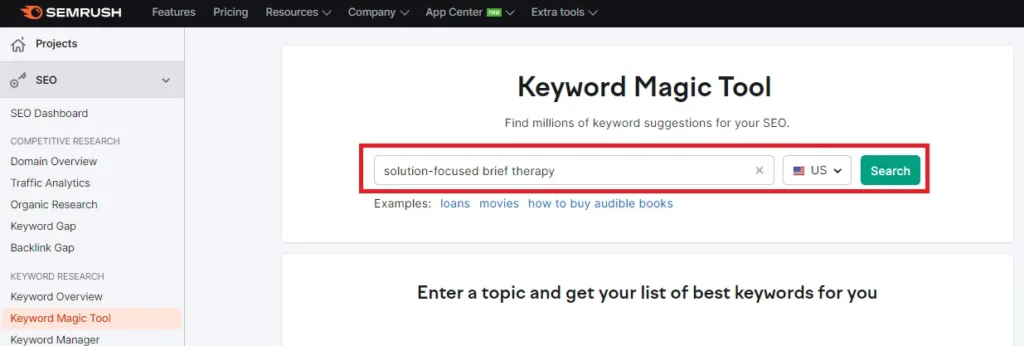
To do this, open the Semrush Keyword Magic Tool and type in a keyword relating to the subject you want to rank for.
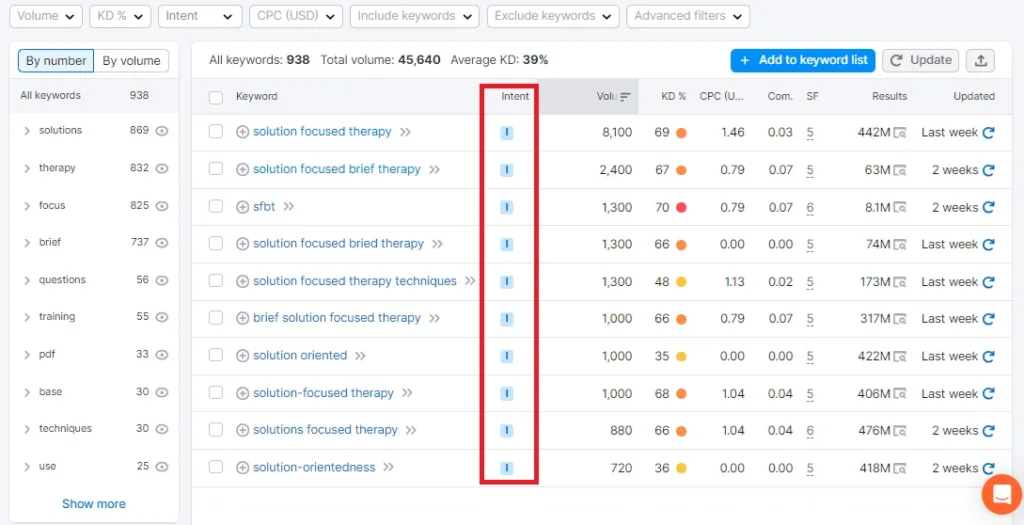
This keyword is run through the Semrush database to present you with the most searched-for terms relating to that keyword.
Among other useful data, you can clearly see the user intent behind each popular search term. In the example above, all of the most frequently searched for terms relating to “solution-focused brief therapy” are informational in intent.
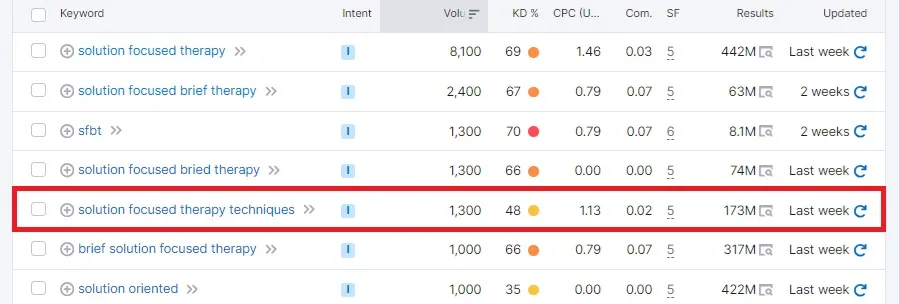
If I wanted to establish myself as an expert on solution-focused brief therapy (SFBT) by creating informational content, I’d likely start with the keyword highlighted above, “Solution-focused therapy techniques.”
There are two reasons for this:
A. It has a decent search volume – Search volume refers to the average number of monthly searches for a keyword. In this example, you can see that our keyword has a volume 1,300 searches per month. This might not be as many as the top two results, but it’s comparable to other keywords that are harder to rank for.
B. It has a relatively low Keyword Difficulty (KD) – Keyword difficulty provides you with a numerical value that tells you how hard it’s going to be to rank your content in within the top 10 search results for your chosen keyword. The higher the number, the harder it will be.
In the example above, you can see that the keyword I’ve decided to target has a lower KD than all but one of the results.
So far, so good, but what if I specifically wanted to create content targeting keywords with commercial intent to help guide potential clients to my SFBT-based practice?

To find those keywords, simply use the Intent filter, select the type of user intent I want to meet, and click Apply.
Semrush will then show the most searched for commercial intent keywords, along with the search volume and keyword difficulty, in order to help me choose which ones to target.
2. Check Top-Ranking Results
Another easy way to quickly understand the search intent behind a keyword is to enter it into Google and look at the top-ranking results for that search query.

For example, say you want to rank for the keyword “online cbt therapy.” Search for that term on Google and you’ll find that the majority of the top results talk about the best online CBT services, helping users to compare different platforms and companies to find the right one to work with.
If you’ve been paying attention so far, you’ll remember that such terms are typically commercial in intent. Users want to hire a service and they’re currently in the stage of exploring and comparing their options.
One thing to note here is that most of the results come from well-established, high-authority websites, which makes it difficult (though not impossible) to outrank them for this particular term.
In this situation, what I might do instead is look at the People Also Ask section, which shows you other terms people search for relating to your search term.
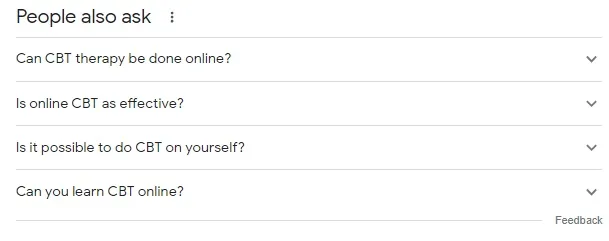
Here, there are a bunch of questions that serve as long-tail keywords with informational intent.
How do I know this?
Because of the way the questions are phrased. These are typically terms that people use when they want specific information about online CBT.
So, rather than go after highly competitive commercial intent keywords, I’d probably start by establishing my credibility and expertise by answering these questions as thoroughly as possible with high-quality informational content.
3. Use Google Search Console
Google Search Console is an excellent free tool for managing your site’s relationship with Google and understanding how users interact with your site.
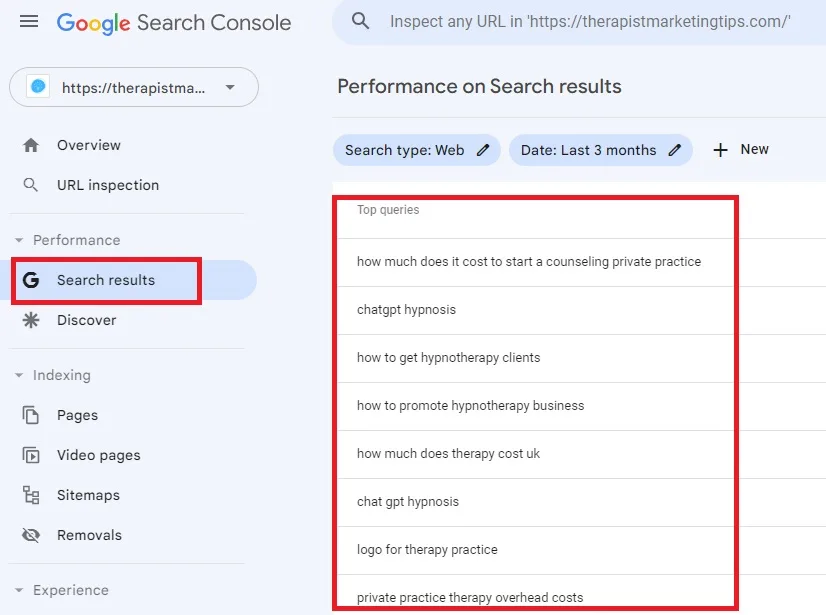
If you have a search console account (and if you don’t, I recommend you get one), you can tap on the Search Results tab to view the top search queries that your content appears in search results for.
Although this doesn’t tell you the intent behind new keywords you want to rank for, it does tell you the kind of content that gets your site the most attention. In other words, the kind of content your target audience wants the most from you.
In the example above, you’ll notice that four of the search queries that draw the most traffic to this blog start with “how.”
What I learn from this is that most of my audience finds my content when they’re searching with informational intent. Armed with this knowledge, I can do a better job at giving my audience what they want (and thus growing my site) by focusing on these types of keywords.
Frequently Asked Questions:
What’s the difference between user intent and search intent?
In terms of SEO, ‘User intent’ and ‘search intent’ are two different terms that mean the same thing: The reason or purpose behind your audience’s search queries.
How does Google understand search user intent?
Google uses a combination of machine learning via its RankBrain algorithm and human Search Quality Evaluators to gain insights into the intent behind search queries and show relevant results to match that intent.
What is high intent vs. Low Intent?
High intent refers to users actively seeking a specific product or service with the intent to take immediate action, such as making a purchase. In contrast, low intent signifies users in the early stages of research or simply browsing, not yet committed to a specific action.
Understanding User Intent: Key Takeaways for Therapists
So there you have it, everything you need to know about understanding user intent and how doing so can improve the way you use SEO to grow your therapy practice.
We’ve covered a lot of ground today, so, before I bid you farewell, allow me to recap some of the most important lessons included in this guide:
- SEO user intent is the foundation of successful Search Engine Optimization – It’s easier to give your audience exactly what they want when you understand why they’re using specific search terms. By creating high-quality content that addresses that intention, you can improve your visibility in search results, drive more visitors to your website, and turn more of those visitors into customers.
- There are five types of search intent therapists need to know about – It’s commonly said that there are four main types of search intent – Informational, navigational, commercial, and transactional. However, private practice therapists will also benefit from focusing on keywords with local intent too.
- You don’t have to guess what your audience’s search intent is – Examining top-ranking search results for your chosen keyword and using SEO tools like Semrush will provide you with valuable insights as to the reasons behind your audience’s search queries.
Enjoyed this post? Get more marketing advice for therapists every week by following Therapist Marketing Tips on Facebook.




